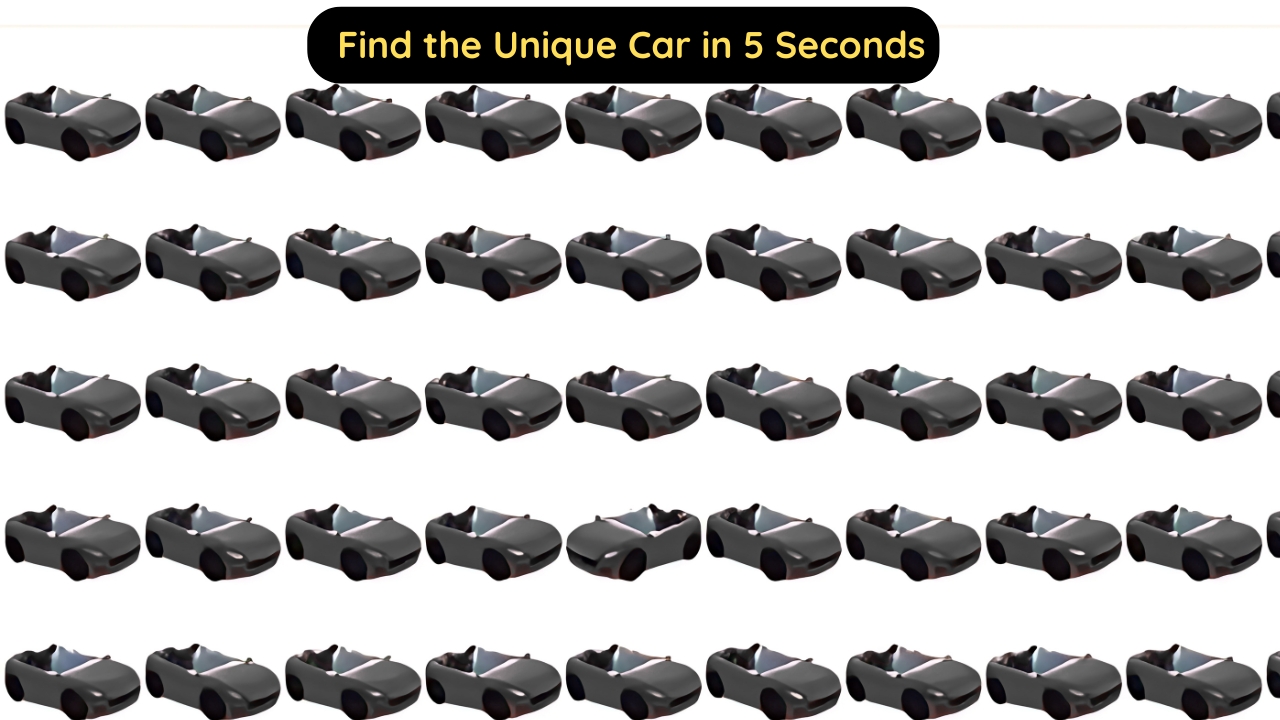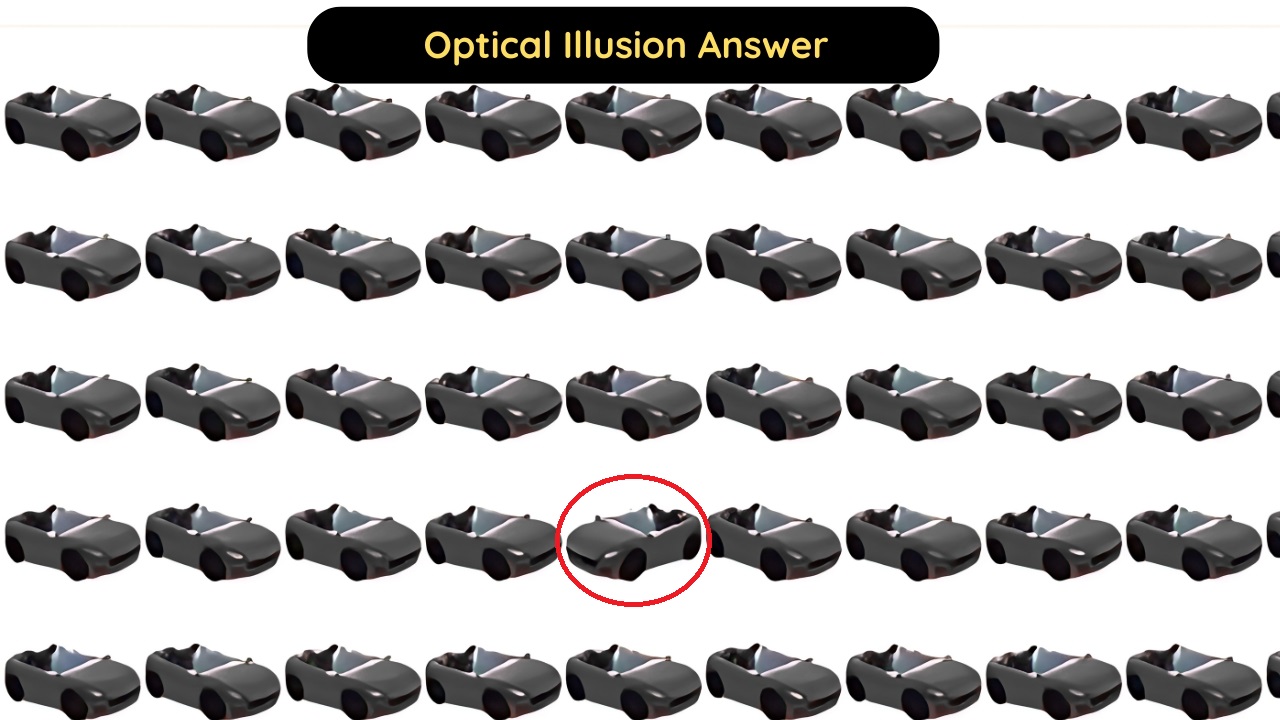Find the Unique Car in 5 Seconds : Optical illusions have long fascinated people around the world, and Australia is no exception. With its vibrant culture, love for challenges, and a knack for fun, Aussies are always up for a brain-teasing activity.
One such viral challenge making waves across the country is the “Australia Optical Illusion: Find the Unique Car in 5 Seconds.” This intriguing puzzle features a grid of identical pink convertible cars, with one subtle difference hidden among them.
The task? Spot the unique car in just five seconds! Let’s dive into this captivating optical illusion, explore why it’s so popular in Australia, and uncover the science behind these mind-bending challenges.
The Challenge: A Grid of Pink Convertibles

The image at the heart of this optical illusion is a 5×10 grid of 50 pink convertible cars. At first glance, they all appear identical—same colour, same design, same angle. However, one car stands out with a tiny difference, and the challenge is to find it within a tight five-second window.
This setup is designed to test your visual perception, attention to detail, and speed, making it a perfect activity for Australians who love a quick, competitive brain teaser.
For those attempting the challenge, the key is to scan the grid systematically. The unique car in this particular illusion is located in the fourth row, third column from the left.
Unlike the others, this car has a slightly different front grille—it’s missing a small horizontal bar that the other cars have. This subtle variation is easy to miss under time pressure, which is exactly what makes the challenge so engaging.
Why Optical Illusions Are a Hit in Australia
Australians have a well-known love for puzzles, games, and challenges that bring people together. Whether it’s a trivia night at the local pub, a Sudoku in the morning paper, or a viral online challenge, Aussies enjoy testing their mental agility.
The “Find the Unique Car in 5 Seconds” illusion has gained traction across social media platforms in Australia, with users sharing their attempts, times, and reactions. It’s become a fun way to connect with friends and family, often sparking friendly debates about who can spot the difference fastest.
The appeal of this particular illusion also lies in its accessibility. You don’t need any special skills or equipment—just a keen eye and a few seconds to spare. It’s the kind of challenge that can be enjoyed by people of all ages, from kids in Sydney to retirees in Perth. Plus, the bright pink cars add a playful, lighthearted vibe that resonates with Australia’s laid-back yet competitive spirit.
The Science Behind Optical Illusions
Optical illusions like this one aren’t just fun—they’re a fascinating window into how our brains process visual information. When you look at the grid of pink cars, your brain initially tries to simplify the image by grouping similar objects together.
This is a natural cognitive shortcut known as the “gestalt principle of similarity,” which helps us make sense of complex scenes quickly. However, this same mechanism can make it harder to spot small differences, as your brain assumes everything is the same.
The five-second time limit adds another layer of difficulty. Under pressure, your brain’s focus narrows, and you might overlook subtle details. This is where the illusion gets tricky: the unique car’s difference is minor enough to blend in but distinct enough to be noticeable if you’re paying close attention.
The challenge tests your visual acuity, pattern recognition, and ability to override your brain’s automatic assumptions.
Interestingly, optical illusions also engage both the left and right hemispheres of the brain. The left hemisphere, which handles logical and analytical thinking, helps you systematically scan the grid. Meanwhile, the right hemisphere, responsible for creativity and intuition, aids in noticing irregularities that break the pattern. This balance of logic and creativity is what makes optical illusions so satisfying to solve.
Tips for Spotting the Unique Car
If you’re struggling to find the unique car in five seconds, don’t worry—there are a few strategies that can help. First, try to avoid fixating on one part of the image. Instead, let your eyes move quickly across the grid, row by row or column by column. This scanning technique helps you cover more ground in less time.
Another tip is to look for specific features that might differ. In this case, focusing on the front grille of the cars can lead you to the unique one faster. Sometimes, it helps to blur your vision slightly or look at the image from a different angle—this can make the anomaly stand out more clearly.
Finally, practice makes perfect. The more optical illusions you attempt, the better you’ll get at spotting differences quickly. It’s like a mental workout that sharpens your observation skills over time.
Optical Illusions in Australian Culture
Optical illusions have a unique place in Australian culture, often popping up in educational settings, entertainment, and even art. Schools across the country use puzzles like these to teach students about perception, focus, and problem-solving. In the art world, Australian artists have long been inspired by optical illusions, creating works that play with perspective and challenge viewers’ expectations.
One famous example is the work of Australian artist Jeffrey Smart, whose paintings often feature surreal, illusion-like compositions. While Smart’s work isn’t an optical illusion in the traditional sense, his use of stark contrasts and unexpected elements invites viewers to question what they’re seeing—much like the “Find the Unique Car” challenge.
Optical illusions also tie into Australia’s love for the outdoors and visual spectacles. Think of natural phenomena like the mirages seen in the Outback, where heat creates the illusion of water on the horizon. These real-world illusions mirror the playful deception of puzzles like the pink car grid, reminding Aussies of the magic hidden in everyday life.
Why This Challenge Resonates with Aussies
The “Find the Unique Car in 5 Seconds” challenge taps into several aspects of Australian identity. For one, it’s a quick, no-fuss activity that fits into the busy lives of Australians, whether they’re on a lunch break in Melbourne or waiting for a mate in Brisbane. The five-second time limit adds a sense of urgency that appeals to the competitive streak many Aussies share—think of it as a mental version of a footy match or a surf race.
The pink convertible cars also evoke a sense of nostalgia for some Australians. They might remind older generations of classic cars cruising down coastal roads, while younger Aussies might associate the bright colour with the vibrant, playful aesthetic of modern pop culture. In a way, the image bridges generational gaps, making it a shared experience for families to enjoy together.
The Broader Appeal of Brain Teasers
Beyond this specific illusion, brain teasers and puzzles have a universal appeal that transcends borders. They offer a break from the daily grind, a chance to engage your mind in a new way, and a sense of accomplishment when you solve them. In Australia, where community and connection are highly valued, these challenges often become social activities, shared and celebrated with others.
The “Find the Unique Car” illusion is just one of many optical puzzles circulating online, but its simplicity and speed make it particularly addictive. It’s the kind of challenge you can try again and again, each time aiming to beat your previous record. For Australians, it’s a perfect blend of fun, competition, and mental stimulation.
Optical Illusion Answer

The “Australia Optical Illusion: Find the Unique Car in 5 Seconds” is more than just a viral challenge—it’s a reflection of the country’s love for puzzles, community, and a good laugh. Whether you’re a Sydneysider, a Perth local, or somewhere in between, this brain teaser offers a quick, engaging way to test your skills and connect with others. The unique car, with its slightly altered grille, may be hard to spot at first, but with practice and a sharp eye, you’ll find it in no time. So, the next time you come across an optical illusion, give it a go—you might just discover a new favourite pastime.
